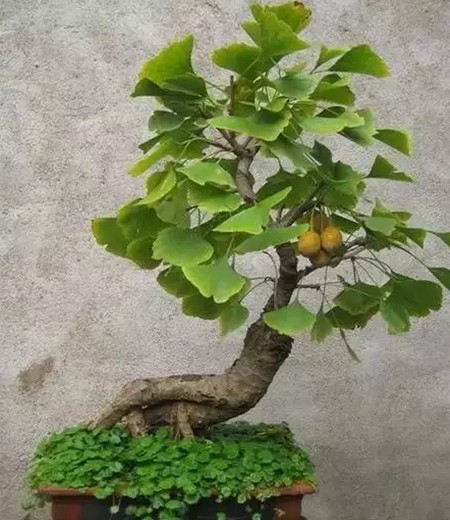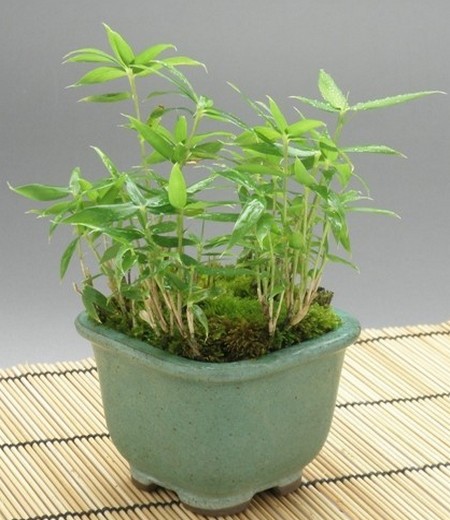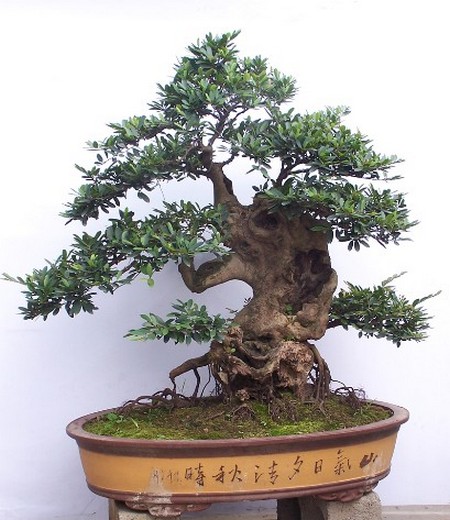Production technology of bonsai of ginkgo biloba
Ginkgo hanging fruit bonsai can be divided into: one branch alone (single branch), two wings flying (two branches), and three tripods (three branches). As the saying goes, "if you have children, you will not plant a ginkgo garden." it means that only grandchildren can benefit from planting ginkgo trees. It can be seen that ginkgo trees grow slowly and bear fruit late. Generally speaking, the forming result of ginkgo bonsai is slower and later. After years of experiments, the author can make the bonsai of ginkgo biloba take shape for 2-3 years and result for 3-4 years.

Potted soil:
Use fertile fine soil, organic fertilizer (such as rapeseed cake, animal manure), mixed with high-quality N, P, K compound fertilizer 0. 5%, the pile is rotten.
Production:
Leave 4-5 small holes for air permeability and water seepage in the lower part of the middle container. Bonsai rootstocks of Ginkgo biloba can be cultivated with seeds or 1 ~ 3 years old seedlings. The seedlings of Ginkgo biloba were heart-picked and bred into rootstocks of single branch, 2 branches and 3 branches respectively, so as to cultivate "one branch alone", "two wings flying" and "tripod stand". In the middle container of seeded or planted seedlings, press 0. 5m × 0. The specification of 4m is placed on flat ground, surrounded by fine soil to conserve water and fertilizer.
Seedling planting was carried out in October. Sowing takes place in spring. Grafting was carried out in autumn at 12-16 ℃ (mid-late March).
Grafting:
1 ~ 3-year-old flower bud branches were collected in the middle of the fruit mother tree and grafted by cutting or split grafting: "one branch alone" scion can use 3 or 4 flower buds, preferably with terminal buds; "Biyi Shuangfei" and "tripod stand" scions have 2 or 3 flower buds per branch.
Choose this period of grafting, the interface can not only heal, but not germinate, and it will blossom next spring. The female flowers were artificially pollinated after maturation. 45 days after pollination, the ovule was obviously enlarged and the seeds entered the prosperous stage, and 2-3 seeds were selected for each branch to strengthen the management of water and fertilizer, which could not only grow seeds from flower buds, but also extract new branches.
In June, the intermediate containers can be removed, transplanted into pots and bowls, and put into the flower market, which will certainly achieve considerable economic benefits.
Fat water:
In order to cultivate ginkgo bonsai more quickly and economically, the only way is to let the seedlings grow on the ground for 3 years (including rootstock for 1 year). The growth on the ground is 1-2 times faster than that in the basin, which is beneficial to the rapid thickening of the stem and the rapid formation of the crown. Suitable fertilizer and water is an important measure to manage Ginkgo biloba. 5 cubic meters of high quality circle fertilizer, 50 jin of diammonium and 100 jin of ammonium bicarbonate should be applied every mu, and nitrogen fertilizer in spring and phosphorus and potassium fertilizer in summer should be applied every year. After the ground dry, combined with watering. During the growing period, leaf fertilizer is sprayed every 20 days, which is usually watered by drought, waterlogged and drained, so that it can "eat and drink well" and promote fast growth and early fruit.
Time: 2019-05-26 Click:
- Prev

Production method of Purple Bamboo Bonsai
Purple bamboo, also known as black bamboo, black bamboo, scattered bamboo, it is bamboo, bamboo pole purple-black, soft and shiny, hidden under the green leaves, very beautiful. Can look at it and remember its name. It can not only be planted in bamboo orchard with yellow trough bamboo, golden jade bamboo, spotted bamboo and other colored bamboo species, but also add color change.
- Next

Key points of bonsai production of Chinese mosquito mother
Chinese mosquito mother, the trunk is low, its shape is different, the leaves are green and evergreen, it is an excellent tree species for making bonsai, it is very precious, if you put a pot indoors, it will show the host's elegance and self-cultivation. It is resistant to drought, waterlogging, pruning, shade, few diseases and insect pests, small leaves and evergreen all the year round.
Related
- Fuxing push coffee new agricultural production and marketing class: lack of small-scale processing plants
- Jujube rice field leisure farm deep ploughing Yilan for five years to create a space for organic food and play
- Nongyu Farm-A trial of organic papaya for brave women with advanced technology
- Four points for attention in the prevention and control of diseases and insect pests of edible fungi
- How to add nutrient solution to Edible Fungi
- Is there any good way to control edible fungus mites?
- Open Inoculation Technology of Edible Fungi
- Is there any clever way to use fertilizer for edible fungus in winter?
- What agents are used to kill the pathogens of edible fungi in the mushroom shed?
- Rapid drying of Edible Fungi

